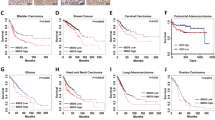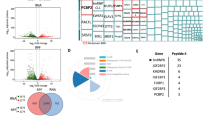Abstract
The tumor-suppressor p53 provides a critical brake on tumor development. HDM2 (human double-minute 2), a p53 E3 ubiquitin ligase, is the principal cellular antagonist of p53. Mounting evidence has suggested that ribosomal proteins (RPs) modulate HDM2-p53 as a novel pathway for regulating p53 signaling. However, the upstream regulators that mediate RP-HDM2-p53 circuits remain poorly understood. Here we identify human coilin-interacting nuclear ATPase protein (hCINAP) as an interacting partner of ribosomal protein S14 (RPS14). RPS14 stabilized and activated p53 by inhibiting HDM2-mediated p53 polyubiquitination and degradation. More importantly, RPS14 was specifically modified with NEDD8 and hCINAP inhibited RPS14 NEDDylation by recruiting NEDD8-specific protease 1. The decrease in RPS14 NEDDylation led to reduced stability and incorrect localization of RPS14, thereby attenuating the interaction between RPS14 and HDM2. Free HDM2 stimulated p53 polyubiquitination and degradation. In conclusion, we demonstrate that hCINAP acts as a novel regulator of RPS14-HDM2-p53 by regulating the interaction between RPS14 and HDM2 through the control of RPS14 NEDDylation. These findings suggest that hCINAP is an important regulator of RP-HDM2-p53 pathway and a potential anticancer drug target.
This is a preview of subscription content, access via your institution
Access options
Subscribe to this journal
Receive 50 print issues and online access
$259.00 per year
only $5.18 per issue
Buy this article
- Purchase on Springer Link
- Instant access to full article PDF
Prices may be subject to local taxes which are calculated during checkout






Similar content being viewed by others
References
Dey A, Lane DP, Verma CS . Modulating the p53 pathway. Semin Cancer Biol 2010; 20: 3–9.
Lane D, Levine A . p53 Research: the past thirty years and the next thirty years. Cold Spring Harb Perspect Biol 2010; 2: a000893.
Moll UM, Petrenko O . The MDM2-p53 interaction. Mol Cancer Res 2003; 1: 1001–1008.
Zhang Y, Lu H . Signaling to p53: ribosomal proteins find their way. Cancer Cell 2009; 16: 369–377.
Narla A, Ebert BL . Ribosomopathies: human disorders of ribosome dysfunction. Blood 2010; 115: 3196–3205.
Pan W, Issaq S, Zhang Y . The in vivo role of the RP-Mdm2-p53 pathway in signaling oncogenic stress induced by pRb inactivation and Ras overexpression. PLoS One 2011; 6: e21625.
Miliani de Marval PL, Zhang Y . The RP-Mdm2-p53 pathway and tumorigenesis. Oncotarget 2011; 2: 234–238.
Zhou X, Hao Q, Liao J, Zhang Q, Lu H . Ribosomal protein S14 unties the MDM2-p53 loop upon ribosomal stress. Oncogene 2012; 63: 1–9.
Zhang Y, Wang J, Yuan Y, Zhang W, Guan W, Wu Z et al. Negative regulation of HDM2 to attenuate p53 degradation by ribosomal protein L26. Nucleic Acids Res 2010; 38: 6544–6554.
Xiong X, Zhao Y, He H, Sun Y . Ribosomal protein S27-like and S27 interplay with p53-MDM2 axis as a target, a substrate and a regulator. Oncogene 2010; 30: 1798–1811.
Zhu Y, Poyurovsky MV, Li Y, Biderman L, Stahl J, Jacq X et al. Ribosomal protein S7 is both a regulator and a substrate of MDM2. Mol Cell 2009; 35: 316–326.
Yadavilli S, Mayo LD, Higgins M, Lain S, Hegde V, Deutsch WA . Ribosomal protein S3: A multi-functional protein that interacts with both p53 and MDM2 through its KH domain. DNA Repair 2009; 8: 1215–1224.
Chen D, Zhang Z, Li M, Wang W, Li Y, Rayburn ER et al. Ribosomal protein S7 as a novel modulator of p53-MDM2 interaction: binding to MDM2, stabilization of p53 protein, and activation of p53 function. Oncogene 2007; 26: 5029–5037.
Dai MS, Zeng SX, Jin Y, Sun XX, David L, Lu H . Ribosomal protein L23 activates p53 by inhibiting MDM2 function in response to ribosomal perturbation but not to translation inhibition. Mol Cell Biol 2004; 24: 7654–7668.
Dai MS, Lu H . Inhibition of MDM2-mediated p53 ubiquitination and degradation by ribosomal protein L5. J Biol Chem 2004; 279: 44475–44482.
Zhang Y, Wolf GW, Bhat K, Jin A, Allio T, Burkhart WA et al. Ribosomal protein L11 negatively regulates oncoprotein MDM2 and mediates a p53-dependent ribosomal-stress checkpoint pathway. Mol Cell Biol 2003; 23: 8902–8912.
Lohrum MA, Ludwig RL, Kubbutat MH, Hanlon M, Vousden KH . Regulation of HDM2 activity by the ribosomal protein L11. Cancer Cell 2003; 3: 577–587.
Xirodimas DP, Sundqvist A, Nakamura A, Shen L, Botting C, Hay RT . Ribosomal proteins are targets for the NEDD8 pathway. EMBO Rep 2008; 9: 280–286.
Sundqvist A, Liu G, Mirsaliotis A, Xirodimas DP . Regulation of nucleolar signalling to p53 through NEDDylation of L11. EMBO Rep 2009; 10: 1132–1139.
Meng G, Zhai R, Liu B, Zheng X . Identification of a novel nuclear-localized adenylate kinase from Drosophila melanogaster. Biochemistry 2008; 73: 38–43.
Zhai R, Meng G, Zhao Y, Liu B, Zhang G, Zheng X . A novel nuclear-localized protein with special adenylate kinase properties from Caenorhabditis elegans. FEBS Lett 2006; 580: 3811–3817.
Granneman S, Nandineni MR, Baserga SJ . The putative NTPase Fap7 mediates cytoplasmic 20S pre-rRNA processing through a direct interaction with Rps14. Mol Cell Biol 2005; 25: 10352–10364.
Juhnke H, Charizanis C, Latifi F, Krems B, Entian KD . The essential protein fap7 is involved in the oxidative stress response of Saccharomyces cerevisiae. Mol Microbiol 2000; 35: 936–948.
Takahashi T, Yano T, Zhu J, Hwang GW, Naganuma A . Overexpression of FAP7, MIG3, TMA19, or YLR392c confers resistance to arsenite on Saccharomyces cerevisiae. J Toxicol Sci 2010; 35: 945–946.
Zhang J, Zhang F, Zheng X . Depletion of hCINAP by RNA interference causes defects in Cajal body formation, histone transcription, and cell viability. Cell Mol Life Sci 2010; 67: 1907–1918.
Santama N, Ogg SC, Malekkou A, Zographos SE, Weis K, Lamond AI . Characterization of hCINAP, a novel coilin-interacting protein encoded by a transcript from the transcription factor TAFIID32 locus. J Biol Chem 2005; 280: 36429–36441.
Malekkou A, Lederer CW, Lamond AI, Santama N . The nuclear ATPase/adenylate kinase hCINAP is recruited to perinucleolar caps generated upon RNA pol.II inhibition. FEBS Lett 2010; 584: 4559–4564.
Ebert BL, Pretz J, Bosco J, Chang CY, Tamayo P, Galili N et al. Identification of RPS14 as a 5q- syndrome gene by RNA interference screen. Nature 2008; 451: 335–339.
Warner JR, McIntosh KB . How common are extraribosomal functions of ribosomal proteins? Mol Cell 2009; 34: 3–11.
Deisenroth C, Zhang Y . Ribosome biogenesis surveillance: probing the ribosomal protein-Mdm2-p53 pathway. Oncogene 2010; 29: 4253–4260.
Dutt S, Narla A, Lin K, Mullally A, Abayasekara N, Megerdichian C et al. Haploinsufficiency for ribosomal protein genes causes selective activation of p53 in human erythroid progenitor cells. Blood 2011; 117: 2567–2576.
Barlow JL, Drynan LF, Hewett DR, Holmes LR, Lorenzo-Abalde S, Lane AL et al. A p53-dependent mechanism underlies macrocytic anemia in a mouse model of human 5q- syndrome. Nat Med 2010; 16: 59–66.
Fumagalli S, Ivanenkov VV, Teng T, Thomas G . Suprainduction of p53 by disruption of 40S and 60S ribosome biogenesis leads to the activation of a novel G2/M checkpoint. Genes Dev 2012; 26: 1028–1040.
Boyd SD, Tsai KY, Jacks T . An intact HDM2 RING-finger domain is required for nuclear exclusion of p53. Nat Cell Biol 2000; 2: 563–568.
Ha BH, Kim EE . Structures of proteases for ubiqutin and ubiquitin-like modifiers. BMB Rep 2008; 41: 435–443.
Vogelstein B, Lane D, Levine AJ . Surfing the p53 network. Nature 2000; 408: 307–310.
Deisenroth C, Zhang Y . The Ribosomal Protein-Mdm2-p53 Pathway and Energy Metabolism: Bridging the Gap between Feast and Famine. Genes Cancer 2011; 2: 392–403.
Sasaki M, Kawahara K, Nishio M, Mimori K, Kogo R, Hamada K et al. Regulation of the MDM2-P53 pathway and tumor growth by PICT1 via nucleolar RPL11. Nat Med 2011; 17: 944–951.
Xirodimas DP, Saville MK, Bourdon JC, Hay RT, Lane DP . Mdm2-mediated NEDD8 conjugation of p53 inhibits its transcriptional activity. Cell 2004; 118: 83–97.
Acknowledgements
We sincerely thank Dr Jian Wang from the State Key Laboratory of Proteomics, Beijing Proteome Research Center for providing plasmids for HDM2 and its truncation constructs. We thank Dr Jun Gu at Peking University for providing the HCT116 cells and reporter plasmids. This work was supported by Grants from the National Science Foundation of China (31170709, 30930020), the National High Technology and Development Program of China (973 Program, 2010CB911804) and the International Center for Genetic Engineering and Biotechnology (project no. CRP/CHN09-01). The funders had no role in study design, data collection and analysis, decision to publish or preparation of the manuscript.
Author information
Authors and Affiliations
Corresponding author
Ethics declarations
Competing interests
The authors declare no conflict of interest.
Additional information
Supplementary Information accompanies the paper on the Oncogene website
Rights and permissions
About this article
Cite this article
Zhang, J., Bai, D., Ma, X. et al. hCINAP is a novel regulator of ribosomal protein-HDM2-p53 pathway by controlling NEDDylation of ribosomal protein S14. Oncogene 33, 246–254 (2014). https://doi.org/10.1038/onc.2012.560
Received:
Revised:
Accepted:
Published:
Issue Date:
DOI: https://doi.org/10.1038/onc.2012.560
Keywords
This article is cited by
-
hCINAP regulates the DNA-damage response and mediates the resistance of acute myelocytic leukemia cells to therapy
Nature Communications (2019)
-
Adenylate kinase hCINAP determines self-renewal of colorectal cancer stem cells by facilitating LDHA phosphorylation
Nature Communications (2017)
-
NEDDylation antagonizes ubiquitination of proliferating cell nuclear antigen and regulates the recruitment of polymerase η in response to oxidative DNA damage
Protein & Cell (2017)
-
The ATPase hCINAP regulates 18S rRNA processing and is essential for embryogenesis and tumour growth
Nature Communications (2016)
-
Regulation of the MDM2-p53 pathway by the nucleolar protein CSIG in response to nucleolar stress
Scientific Reports (2016)



